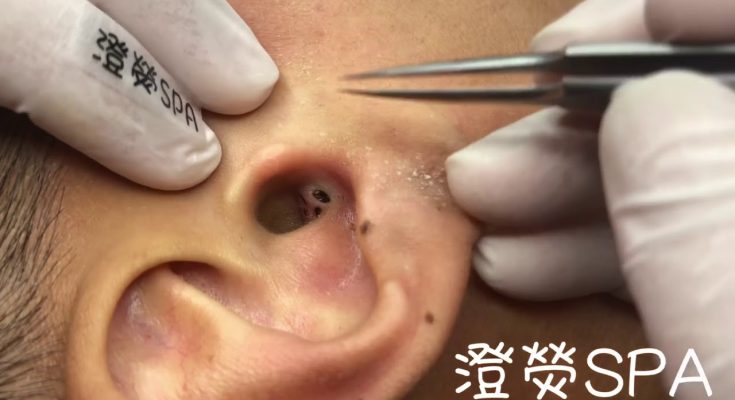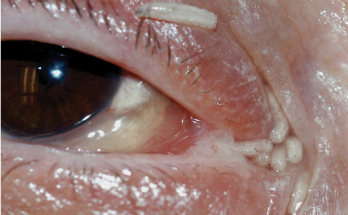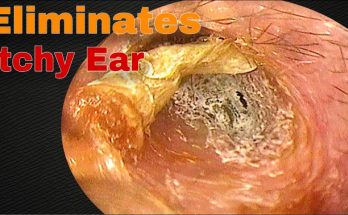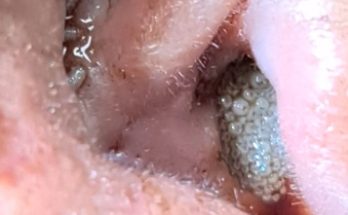We include products we think are useful for our readers. If you buy through links on this page, we may earn a small commission. Here’s our process.
How we vet brands and products
Your ears are particularly susceptible to blackheads because they often aren’t given the same preventive treatment as your face. Treatment can include exfoliation and acne treatments.
Blackheads are one form of acne, a type of inflammatory skin condition that’s caused by clogged pores. While blackheads are commonly linked to areas of the “T-zone” (chin, nose, and forehead), they can occur anywhere.
Unlike other types of acne, such as cysts, blackheads aren’t linked to bacteria. They’re caused by a combination of oil (sebum), dead skin cells, and dirt that clog your pores and create a hardened substance. The top of the pore is left open, and the plugged material oxidizes into a darkened color.
Read on to learn how blackheads are formed and how to treat them on your ears.
Everyone has oil glands — in fact, these are necessary for natural skin hydration. Oil glands only become problematic if they become overactive and produce too much sebum. This is most often the case in people with oily or combination skin types.
The following risk factors can also increase your number of clogged pores, leading to more blackheads:
- hormonal fluctuations
- prescription medications
- stress
- family history
Although whiteheads also stem from clogged pores, they have closed heads. This creates the white cap that you see on the skin.
You’ll follow the same steps to get rid of a blackhead in your ear as you would for blackheads on other parts of your body. The difference, though, is that the skin on your ears is more sensitive, and you also can’t see the area easily.
Consistency is also important — it can be easy to forget your ears compared to more visible areas, such as your face.
One of the best ways to remove the excess oils and dirt that can build up in your ears is to wash them every day. This is easy to do in the shower, and you may even be able to use your regular face cleanser. You can use your fingers or a soft washcloth.
Choose gentle foaming, oil-free products, such as:
Avoid over-scrubbing your ears, as this can irritate your skin and cause more acne.
You may already know that exfoliation is important for your face and body. It helps to remove dead skin cells that dull your skin tone and clog your pores. This also includes your ears. You can gently exfoliate the delicate skin surrounding your ears once a week. This is best to do the shower.
Apply the exfoliating wash with your fingers and rub gently. The following products may help:
Certain over-the-counter (OTC) acne medications can also help unplug blackheads in and around your sensitive ears. Salicylic acid is a helpful OTC medication that works by unclogging pores and stripping away dead skin cells. Other acne medications like benzoyl peroxide are also useful.
Salicylic acid is available in numerous acne products. Astringents and toners are the most common, although some cleansers have it, too. When using a salicylic acid-based cleanser, such as Dermalogica Clearing Skin Wash, use this in place of a regular cleanser in the shower.
You can also use your regular cleanser and follow up with an astringent, such as Neutrogena Clear Pore Oil-Eliminating Astringent. When using an astringent, use once a day to start. If your skin doesn’t develop any irritation, you can apply twice daily in your ears with a cotton ball or Q-tip.
Extraction may be a last resort for stubborn blackheads in the ear. Rather than using fingernails or bobby pins, you’ll want to buy an extraction tool that won’t leave marks or cuts on your skin.
Still, even professional-grade extraction tools can be difficult to use in your ears. You should:
- First, press a warm washcloth on the area to soften the plugged pore.
- Use a sterilized extractor by pressing the metal loop on the edge of the blackhead. Then, sweep it across to extract it.
- Be sure you don’t press the tool directly onto your blackhead — this can cause your sensitive ear skin to tear.
- Wash your ear and sterilize the extractor again after you’re done.
Although at-home blackhead removal methods can work for some people, it doesn’t work in all cases. If your blackheads come back in your ears, or if you have a widespread case throughout the area, it may be time to see your dermatologist.
A dermatologist can help with ear blackheads in a few different ways. With professional extraction tools, they can first remove the blackheads safely and thoroughly. This could be much more effective than doing the extractions yourself since you may not be able to see inside or behind your ear very well.
If you have recurring blackheads in the ears and other areas of the body, your dermatologist may prescribe acne medication. Keep in mind though that many of these products can make your skin sensitive to the sun, so be sure to wear plenty of sunscreen to avoid burns.
Another way to get rid of blackheads in your ear is to help prevent them in the first place. Such a task is dependent on keeping your ears clean and free of excess oil. Most of the treatments don’t treat the blackhead itself but prevent others from forming. Consider the following steps:
You should:
- Wash your ears every day. Removing excess oil from your ears can reduce the number of clogged pores in the area.
- Shampoo your hair daily. This helps prevent oil that and dirt buildup from your hair going into your ears. If you must skip a wash, use a dry shampoo and keep your hair pulled back.
- Wash and clean items that touch your ears weekly. These include earbuds, pillow cases, cell phones, and other items your ears are regularly exposed to.
- Use noncomedogenic skin care products on your ears. Whether you apply the occasional body lotion or sunscreen on your ears, going noncomedogenic means that you’re using products that won’t clog pores.
- Avoid popping blackheads with your fingers or nails. Ultimately, this can cause irritation and may lead to further breakouts. Scarring can also occur.
- Don’t apply acne products more than recommended. The skin in and around your ears is sensitive and more prone to irritation from too many acne products. Plus, if you dry out your skin too much, your oil glands can produce even more sebum that can lead to even more blackheads.



